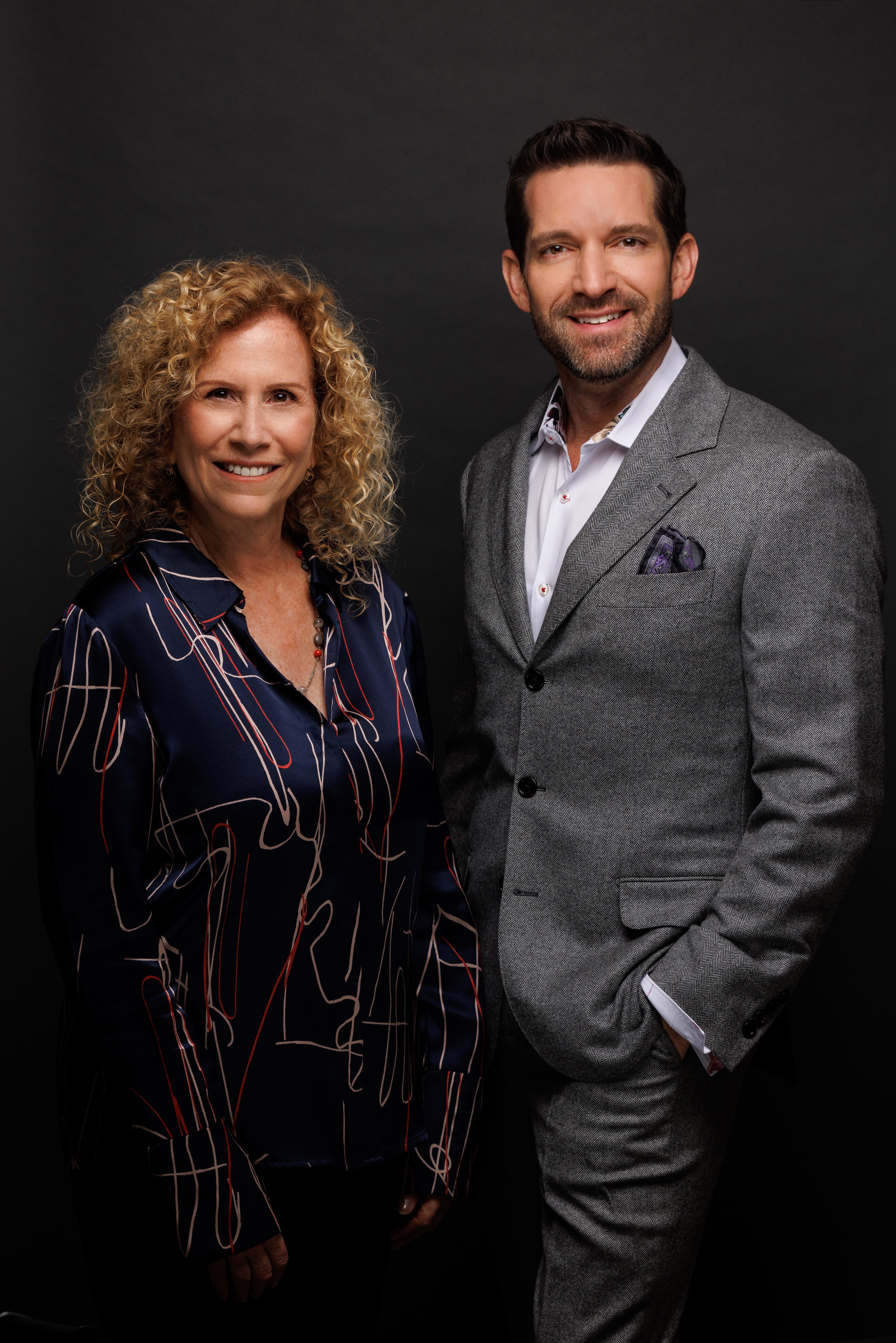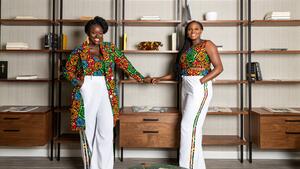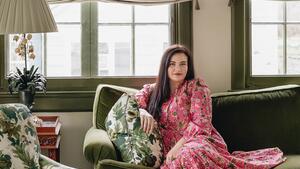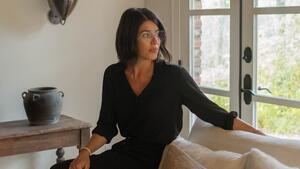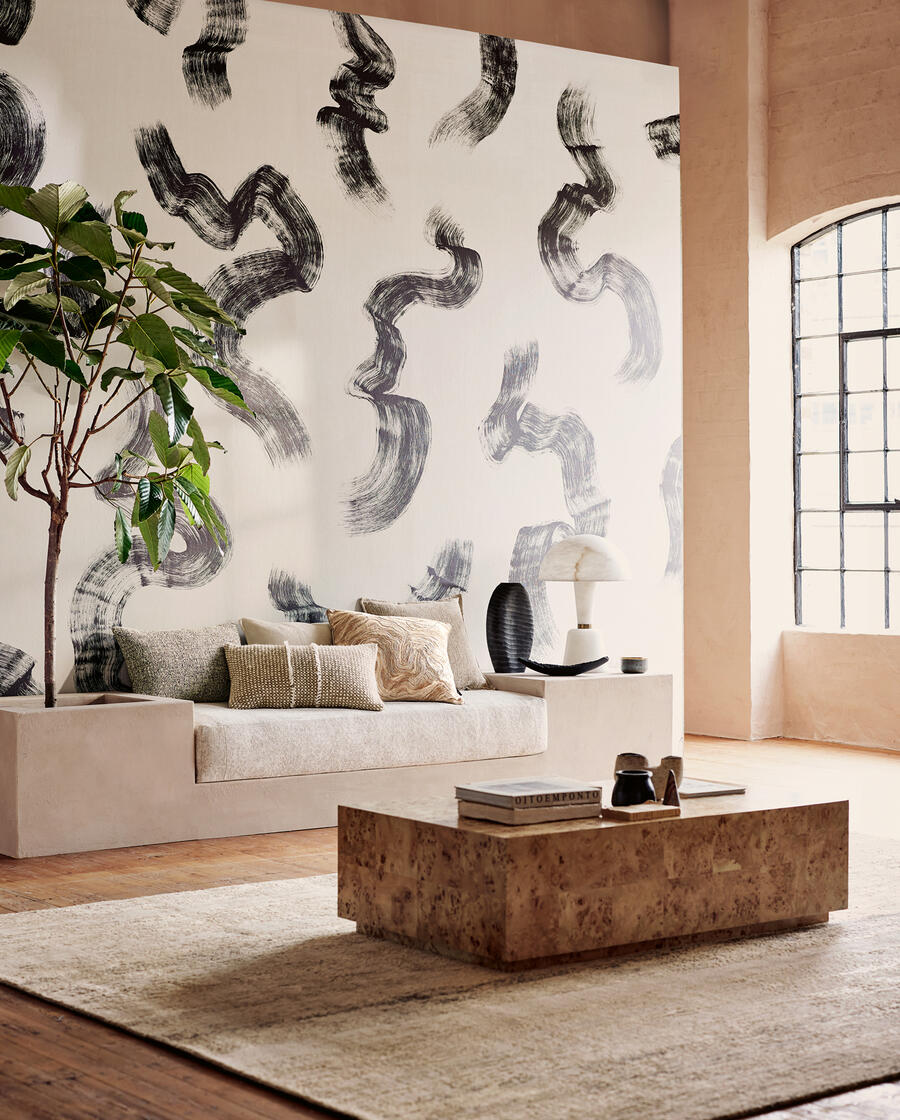The 50 States Project is a series of candid conversations with interior designers across the country about how they’ve built their businesses. This week, Florida designers Faith Fix and Dwayne Bergmann tell us why they recently merged their individual firms, Freestyle Interiors and Dwayne Bergmann Interiors. Along the way, they chatted about how their business backgrounds created a shared foundation for them as firm principals, why they believe luxury design requires a custom billing framework, and how they’ve created a collaborative, low-drama team even as their staff adjusts to the new business structure.
What was your path into this industry? Did you always know you wanted to be a designer?
Dwayne Bergmann: No—neither Faith nor I had a traditional introduction into design. Ironically enough, we both have business degrees. I have an MBA and Faith was a CPA. So we both established one side of our brain before we allowed our true passion to take over.
I grew up in a small Midwestern town, and design was always something I was interested in as a child. My grandfather, uncle and father were very engaged in the residential construction business, so I had that exposure growing up, but I also grew up riding and showing horses. I turned pro, had some early success and won some very cool titles, then decided that I would go back to college and finish my degree. I didn’t really know what I wanted to do at that point, so I thought a business degree was probably the best avenue to take.
I studied business with an emphasis on human resources and psychology. I chose that focus after listening to a speaker at a leadership conference who made a major impression on me with his presentation about how companies would differentiate themselves in the future. Technology was becoming more accessible to everyone, and the message was: The last true resource and differentiator will be people. The companies and the leaders that understand how to develop and lead talent will be the individuals who can accomplish the most. So I put a lot of emphasis on learning how to develop, manage and lead people from a human resources perspective.
I think that has a direct correlation to my success in the design field, which is to be able to read people, as well as the nuances that come into play with negotiating and selling. But first, those skills were required to be successful when I worked on Home Depot’s wholesale professional division, HD Supply. We were engaged with clients like W Hotels and Four Seasons, working on projects in places like Turks and Caicos or Bimini Bay in the Bahamas, or on large residential developments. We would supply plumbing and electrical building materials, set up design centers and things of that nature. It was a great developmental experience, and I learned a significant amount about this industry. It was a nontraditional way into the luxury residential design business.
What ultimately made you pivot?
Bergmann: A few things. One, I bought my first home at the age of 20. I bought a little fixer-upper and cosmetically changed the entire home, without a professional helping me. When I sold it, I made a really nice profit, and the buyers wanted everything—they asked for my art, my furniture, dishes and accessories, all that stuff. I basically just took my clothes and cashed a check and left, and I didn’t think anything of it. I did probably four or five houses that way throughout my 20s. At the time, I didn’t realize that [most] people couldn’t just walk in and envision how a house could look if you repainted and used a different tile and moved a wall around or decorated a certain way or changed light fixtures and added the wall treatment. After the fourth or fifth remodel, some of my friends and family were like, “You know, you really should consider doing this professionally. You have a gift.” And I was like, “You’re crazy.” But as I became more exposed through Home Depot, I started getting involved with building drawings and working on these projects, and I definitely had a knack for it, so I started taking on a couple of side projects.
One day, I got a call from a total stranger who said, “I’ve had seven people tell me I should call you to help me with this project.” I said, “I’m not a professional designer. I have a ‘real’ job.” That’s the word I used at the time, believe it or not: a real job. And she was like, “I don’t care if you do or not, I want you to do this. You can do it on the weekends.” So I met her and realized that if I could do this for her, I could probably do this for anyone, because there were a lot of demands and it was a difficult project stylistically. I did the project, she was really happy, and my phone started ringing. That’s when I resigned from Home Depot.
My first year, we had eight or nine projects, which is insane that it took off that quickly. And from there, we never looked back. I started working out of the loft at my house with an assistant and one other individual who’s still working for me. We moved from the loft to the garage, then to a co-op workspace, then into a 3,000-square-foot showroom. Now we have a 13,000-square-foot location in Fort Myers, a 1,500-square-foot studio in Naples, and I have the new business that I just acquired in Bonita Springs. We have a millwork shop, a marble import slab business and some commercial real estate. It’s been a beautiful journey. It’s the best thing I’ve ever done. I don’t feel like I go to work every day. This year will be my 10th year anniversary, and it seems like [I started my firm] just yesterday.
What was the motivation behind all of the different ways that you’ve diversified your business?
Bergmann: Vertical integration and, honestly, control. The dependencies that a business needs to have on other specialty areas in order to execute the design is very challenging. We’ve come up with some very intricate cabinetry and millwork designs, and I’ve just gotten so frustrated with quality control and execution that I just bit the bullet and said, “I want to vertically integrate.” That’s been the plan for all of the additional five businesses that I’ve brought on to [have more room to] play, [and increase] access and quality.
What about you, Faith? What was your path to founding your firm?
Faith Fix: Well, it’s another very unusual one. I am a CPA; I went to school for accounting. And I was married to a fellow who was a woodworker. He also got a finance degree and hated what he was doing. So one crazy weekend, we drove from Miami, where we’re both from, to Sarasota, because my husband had family friends who had a contemporary furniture store. We walked into this store, and we just got so excited and energized. We left high as a kite, and came home and said to our parents, “We want to do this.” The couple [who owned the store] was lovely and said, “We will teach you this business.” So we moved to Sarasota and spent a year learning the furniture world.
We became a franchise and were choosing where to open a new location. It was between Boca Raton and Fort Myers, and Fort Myers was the fastest growing, so we said, “Let’s go there.” We ran the franchise there for about five years. [Over that period, we] realized that we were younger than the [owners of the brand, and] that we had these expansive ideas, and that our focus was not going to be exactly what theirs was. We went to them and said, “We love you. We couldn’t have done this without you. But we’d like to spread our own wings.” So we parted ways. And that’s when we changed our name to Freestyle.
[We were all about] jumping in feet first—we were very visual, quick learners. It started with people saying, “Can you help me with one room?” And before you know it, that became whole houses. And then we got asked to do our first model home, and it just kept going from there.

How did you and Dwayne start thinking about taking this next step together?
Fix: We met at an industry function, and Dwayne reached out and said, “Hey, business owner to business owner, would you ever chat?” And I said, “Absolutely.” That was—what, two years ago? We started having monthly phone calls: “How do you do this? How do I do that?” It was so great to share our secrets, and it became a friendship.
What did that add to your business for each of you?
Bergmann: [I have] a tremendous amount of respect for what Faith has built. She’s an industry veteran and has an amazing reputation in southwest Florida, and specifically in the Naples–Collier County market, where she is the go-to firm. I was going into my eighth year of business and was at this point of deciding how to grow. From my perspective, the biggest challenge was that the name of my firm is Dwayne Bergmann Interiors, so when a client contacts my firm, there is this expectation that they’re going to work with me, even though I have a team of amazing designers. I had a lot of questions around how Faith runs her business because she had made that transition from Faith Fix Interiors to Freestyle Interiors several years before.
Fix: It was a transition to train people to know to recommend and refer to Freestyle, and to reach out to me but not put my name front and center.
What was the impetus for you to make that change?
Fix: I realized early on that if I wanted to grow the business, I could not be the sole face of the company. I was the face of the company in my leadership role and design directorship, but as I started to gather designers who were extremely talented, I wanted them to shine, too, and it dawned on me that I needed to shift the focus.
How long did it take for that shift to stick?
Fix: It took about two years.
Dwayne, going back to the name of your firm—were you exploring a similar transition?
Bergmann: Ironically, when I started my firm, my initial instinct was to name the firm Expotique Home. I’m glad we didn’t name it that, but the thought process was to create a brand. However, my advisers at the time—namely, my marketing and PR agent—said, “Look, you have way too much social capital with your name,” because I was very involved in our community from a philanthropic standpoint. They said, “You’re going to be able to grow your business much quicker by using your name.” And it was true—we grew quickly and were in that three- to seven-associate range doing volume that a lot of firms take 10 to 20 years to do, so it was good advice. But then that’s where we hit a plateau.
It was interesting to hear how Faith had made the transition, and I was starting to explore that. I also shared with Faith that I had recently looked at acquiring another business on the east coast of Florida just prior to the pandemic. During the pandemic, both parties said, “This isn’t the right time to pursue this.” But part of the attraction of that acquisition was the fact that that firm was a generically branded firm that would allow me to start creating a different identity, which was really the only way that I could see being able to grow without becoming a celebrity designer. That was the pivotal point that started to change the course of our conversations—from sharing business practices and ideas to the beginning of a conversation about growth by merger acquisition. That’s what opened the door for Faith to ask me if there would be any interest in a conversation about our firms coming together.
Fix: In the two years we’d been talking, I had gotten to know Dwayne, and he’s brilliant. He’s a true entrepreneur, and he has just exploded vertically and now horizontally in his acquisitions and growth. It’s really exciting for me to watch him do what I would have done if I was 30 or 40 years younger.
Bergmann: I love the fact that we’re coming together now—and for as long as Faith wants to continue in her career, we can do amazing things together, which is super exciting.
As you were having these long conversations, what was important to each of you to bring to the partnership and to get out of the partnership?
Fix: I needed to trust Dwayne and his integrity. As I got to know him, it was exciting to see that we had similar sensibilities around business and design, and we both have equally strong left and right sides of our brain. So I was excited to share that journey with someone. You can often feel alone as a business owner, even if you bring in wonderful associates—there’s still a little bit of loneliness. [Now] I wake up feeling like I’ve just started the next phase of my career in such an exciting way. I don’t think that at the time we knew that he would be embarking on a couple of peripheral businesses that only add to what we can offer. It’s very exciting from a designer perspective and a business perspective.
Bergmann: We developed trust quickly. And I like her—I genuinely like going out and having dinner with her. We traveled to Paris for Maison&Objet, and it was truly a pleasure. I have respect for what she’s developed as a business, with 40 years of experience going through the ebbs and flows in this industry—having access to that knowledge base is invaluable. [This partnership comes with] a built-in mentor.
I think what I’m bringing to the table is maybe a renewed sense of energy and also longevity for Faith’s brand, Freestyle. The plan is to grow the Freestyle brand as a broader business, and Dwayne Bergmann Interiors will be reserved for a small number of exclusive projects, as well as my products and furniture. Unfortunately, with a lot of interior designers, they have these amazing businesses but the exit strategy might be a little bit dismal. Like, what happens? Faith has grown this business for a long time, [and now] the Freestyle brand is going to continue to grow and prosper and evolve.
Fix: When I was Dwayne’s age, I did want to expand and explode, and I was always waking up with great ideas, but at the time, I didn’t have the financial backing or someone to say, “Go for it.” Dwayne is almost like me at a younger age, but he has more ability to make his dreams come true. There’s a synergy that’s wonderful. We’re complementing what each other needs in this moment.
I’ve talked to a lot of designers who started in partnerships early in their careers but ran into roadblocks and had to start over on their own. There’s something unique and beautiful about partnering later in your career. You each know who you are and how you want to run your business, and now you’re bringing all those strengths to a partnership. Is that something you feel as well?
Bergmann: I completely agree.
How much do each of your very established businesses need to bend to make room for each other?
Bergmann: That was definitely a big part of our conversation. We spent several months exploring the cultures of our company—not only the attitudes of our team members, but also the aptitude for what we thought they would be able to handle. Very little about this process was left to circumstance. The last six months, we were meeting every other week. The last three months, we were meeting every week. We were very direct with each other about not knowing exactly how the execution of blending our companies was going to come through. But we knew we were going to approach it with positive attitudes because that’s the culture of both firms. There was more emphasis on the culture aspect and less on “OK, this is exactly how it has to work from day one.”
Let’s manage our team. Let’s manage the communication. Let’s manage the feelings and the emotions. And honestly, the details. We’re still working through some of the back-end things, creating efficiencies. Going into it, [we were realistic about the fact that] we’re not Fortune 500 companies with thousands of employees. So where do you need to prioritize your time? If we had prioritized all the black-and-white details of every accounting report and operating procedure versus messaging and the impact on our people, I think we would be in a different position right now. So we focused on the latter, knowing that our business and communication skills and our operational teams are really strong. [We knew] we would be able to work through [the other aspects later]. And that approach has worked really well.

When did the partnership officially take effect, and how did your clients react?
Fix: January 1. I am still telling clients one by one because it really doesn’t affect them. But I’m telling them, so that they’re not surprised if they hear about it. Actually, the response we’re getting out in the world is from architects and contractors as well: “How do I do this?”
Bergmann: They’re like, “Tell us, we want to know how you can make this happen.” So we could go on a road show, if you’d like.
Fix: When I told my staff, that’s when I was so nervous. I did not know what their reaction would be. I always give an hourlong talk at the beginning of the year about where we’ve been and where we’re going. I spent a lot of time preparing it, and at the end, I had to make this major announcement [of the merger]. And they applauded.
What was the reaction you were worried about?
Fix: Fear of change.
As principals, how have you felt the difference in your own day-to-day?
Bergmann: There is a different sense of peace. You have to be fairly high-strung in order to work at the pace that we work.
It’s frenetic and crazy and high stress.
Bergmann: Exactly. And look, I have a strong COO who has to hear me vent occasionally—or more than occasionally—but it is different than being able to call someone who has been doing the exact same thing that you’ve been doing and vent. And when you’re done, to get the question, “Are you venting? Or would you like some feedback? Because I’ve been in that situation before.” That provides a sense of peace for me that I have not had since opening this firm.
Fix: You feel like you have a true partner. Dwayne has a COO, and now I do too—I took his advice and hired someone in that same role for my firm. We’ve been taking each other’s advice and incorporating each other’s ideas for almost two years now.
Bergmann: We have a lot of details that we’re still tackling. We interviewed candidates today for some new positions, and it was really fun, and it’s the first time we’ve done that together. So we have a lot of firsts that we have to go through. But I know that we both can count on each other.
Fix: And when we come up with an issue, it’s “OK, what can we do to solve this and make it run smoother for our new joined company?” I have always tried to manage the chaos and create simple-but-effective systems, and Dwayne feels the same way, so I feel like we can talk the same language.
When you look back, what did you prioritize as you were growing your teams, and how has that shaped the way you grew and evolved your businesses?
Fix: I’ve grown my team twice now. I did it pre-2008 crash, and then had to completely shrink down, and then grew my company again. In the second round, I felt like I was wiser. And funny enough, Dwayne’s team is very similar. We both chose to start hiring with the design team. They were mature designers. In residential design in particular, it really is about [having] passion and experience. The few times I hired younger designers, sometimes they left to go start their own thing, or they just didn’t have the skill base. We work in luxury, high-end design and we work from the ground up, so you have to have both construction and furnishing capabilities. I loved inviting different designers to come from around the country and the globe to work with us. They brought great perspectives and newness to our firm. And I wanted them to shine. I wanted them to feel like they could always have a home at Freestyle and grow and be appreciated, and it was their name in a magazine when it was their project. And so I first got that base [staff hired], and then needed [to add] the support staff. I have more administrative and logistics staff than I ever imagined. But it works, it feels right.
Dwayne, how did that go for you?
Bergmann: It’s unfortunate, but Faith and I commiserated on the challenges of developing talent in this industry. We both have experience with junior designers where there is a lack of appreciation for the job skills that they were learning, and where the expectations to become a senior designer—not only from a compensation perspective, but even from a control perspective and trying to influence and communicate with clients—was not [realistic]. This is a very on-the-job learning environment. You can come out of the best school of design, and you’re not prepared to be successful in this industry. It takes four to eight years before you could really handle a project on your own. And that’s a project—not multiple projects. So [to hire] a junior designer in a firm like ours and to [help them] be successful, not only from an experience [perspective], but also from a profitability [perspective], it’s a huge investment. And unfortunately, neither one of us have had the experience where there’s an understanding and a recognition of that [among] the junior designers. I learned that really quickly and pivoted to a very distinguished, well-trained and mature design team. The least experienced designer on my team probably has 20 years of experience.
So you have no design-assistant-level staffers?
Fix: We do now, but we call them project managers, not design assistants.
Bergmann: And the project managers don’t have the same expectation that they’re rising to become a senior designer. Faith even had one who was a designer who was like, “I don’t want that pressure anymore. I want to just be in a support role.”
Who is the ideal project manager candidate in that environment?
Fix: Top [requirements are] communication and organizational skills.
Bergmann: They have to be extremely good at written and verbal communication, problem-solving and organizational skills. I have one very successful PM who was a paralegal and managed five attorneys, and she’s [like], “You think this is crazy? Go manage five attorneys. This is nothing.” She can do spreadsheets on one screen and PowerPoints on another screen and answer vendor calls on her phone. I also think by focusing on a staff that’s been in the workforce for 15 years, our drama is very low. Our culture within our firm is about everyone wanting to get along and to get their job done.
I want to go back to the idea of not being the name—of not having clients always expect to work with you. It sounds like that approach makes it easier to empower designers on your team. What does that look like in practice? How hands-on are you with each project?
Bergmann: We currently have slightly different approaches. My primary design role is the creative director for the firm, as well as CEO on the business side. This was one of the major attractions about our businesses coming together and being able to move more of our future design projects into the Freestyle category, where there is an understanding [among clients] that you are assigned a designer based on an intake of your personality and style preferences. The understanding from the client is that there is oversight, but your designer is the person you’re communicating with, who is managing your design concept and execution. Whereas today, as the creative director for my firm, I have been overseeing the majority of the design plan—reviewing selections, reviewing presentations—and it’s been overwhelming.
For how many projects?
Bergmann: I don’t want you to print that because every client needs to know that they’re our only client. [But] I work all the time, and this can’t be sustainable for 40 years—there has to be a change in order for this to work. Now what I’ve been able to do over the last 18 months is start communicating to our clients that my role as the creative director would be involved at the conceptual design phase. And then once we established that design direction, a senior designer would become their main point of contact and execute the rest of the project. That has worked for probably half of the projects, and for the other half, the clients were like, “No, I hired you. I don’t want to hear from somebody else. I want you.” So those have been dialed back, and I’m down to around seven right now that I am finishing. I’m striving to have no more than 10 projects with a three-person support team [that includes] two designers and an assistant. My designers are really excited about getting to lead the project from the very beginning without me having to bless their designs. Some of them have been doing this for 35 years, and they should just be able to present [and execute] their design, and [have] the clients confidently know that the design is amazing [without me having to affirm that].
Faith, how did that transition play out for you?
Fix: What Dwayne just described is pretty much how I’ve managed my clients for the last decade. I’m the rainmaker—all the work comes in through me, not my designers. I listen to who they are, their personalities, and I have great instincts on putting designers together with clients. I hear all the time, “Thank you Faith. It’s a perfect match. We’re very, very happy.” But I tell them, I’m part of every project. I do check-ins with them regularly. I love to go to sites. I love the construction piece. I see and review every set of drawings. What my designers really like is that behind the scenes, I am supporting them. They come to me with a lot of design questions, and they’ve always said, “Faith, we appreciate that you have our backs.” When I go into any client meetings, I’m very careful to say, “We,” and make sure the client understands that this designer has my respect, and let them know that I’m always keeping an eye on things behind the scenes. I like it because I love people, and I love the service aspect.
Dwayne is right that it’s very important for clients to feel that we are more of a boutique-size firm, even though we’re larger, that the scale is more about the support and logistics, and that each designer is given only the amount of projects that they can manage well. Some [of my designers] knew of Dwayne [before the merger] and some didn’t, but when they viewed his work, they became excited about having him provide them with that same support and inspiration behind the scenes. They feel like they’re going to learn from another really special designer and his team. The merging of all of our teams feels like it’s going to have some great synergy. There’s no sense of hierarchy—everyone’s on the same playing field, and they are all very happy to share ideas.

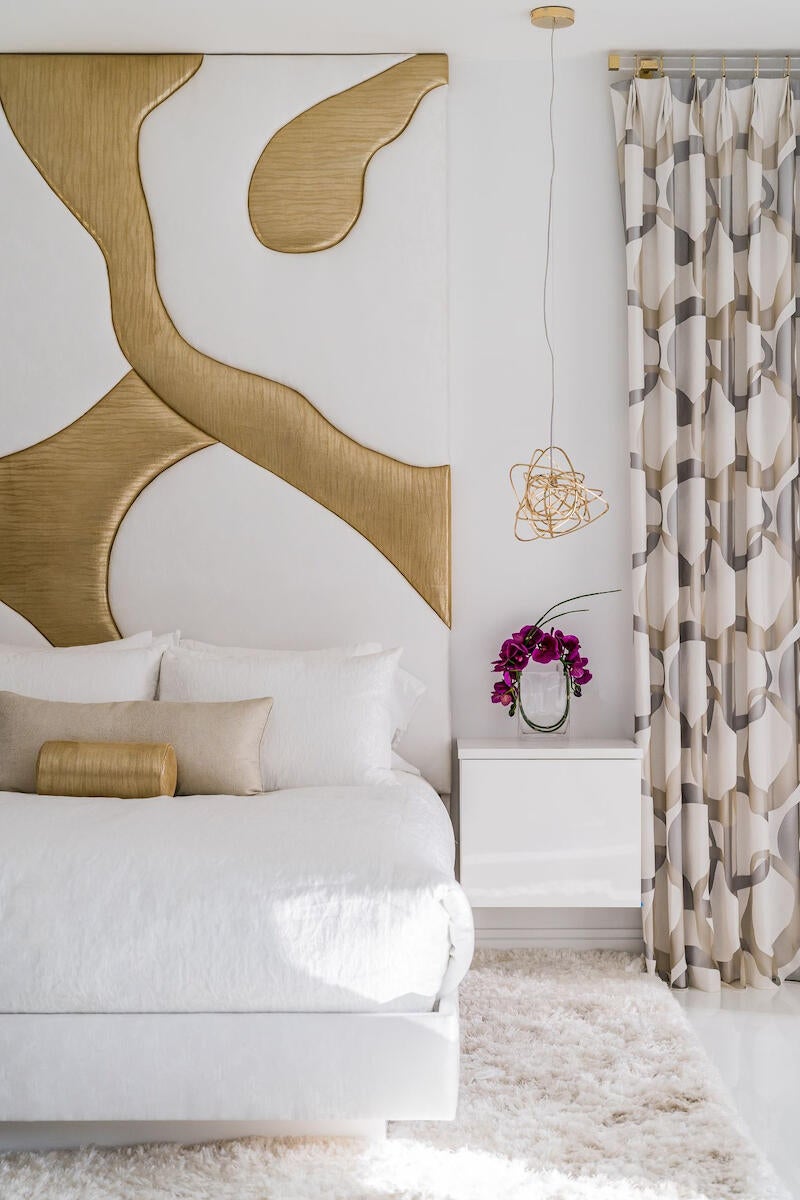
How have you each approached billing, and does this transition change anything about your approach?
Bergmann: We both had similar philosophies of having hourly and possibly fixed design fees depending on how the project was set up and based. So we have come together on some of the details of expectations with different types of contracts. But we didn’t have to do a major shift from either firm to be able to have a consistent approach.
Fix: And while we have a concept of how we prefer to do our contracts, we are willing to adjust as needed, per project.
Neither of you are like, “My way or the highway.”
Bergmann: No. One of the things we found out early in the process is that when we are interviewing clients, we’re going through a discovery process. And we’re in the business of delivering not only a custom product, but a custom experience. So some clients need more communication, some need less. Some need education; some need facts and details; some want numbers first; some want designs first. Faith and I are not forcing our designs, nor are we forcing a singular business model down a client’s throat. We’re saying, “We listen first, we understand you first, and then we look at the options that we are comfortable providing. And if our options match what we believe will create the best experience for you, then we move forward.” But I think the idea of saying, “This is the only way that we do business,” when we are saying we’re in the luxury, custom residential design business, just seems to be a little bit hypocritical. I have found it to be nearly impossible to say, “Here is the one and only way that we should conduct our business.”
What does that flexibility require of you as a business?
Fix: We need to know what it costs to stay in business—to pay our employees well and service our clients. When you know that, you understand where you can have some flexibility, but there is a minimum requirement for us to take on a project, and that’s based on a client having respect for the value of what we’re going to provide for them.
It would not be the 50 States Project if I didn’t ask you about Florida—and with your many locations, I feel like we get to talk about a whole lot more of the state! What, for each of you, is unique about the cities where you are based?
Fix: I grew up in Miami, so I spent the first half of my life there, and then decided to move to the west coast for a variety of reasons, number one being the fact that it was smaller and growing. I started my business when I was 23, and now that I have children who are way older than that, I think, “Wow, what was I thinking?” But it felt comfortable for me to start in a place that was growing, and the south of Florida was way different than it is now. But Florida is a wonderful place to call home because of the warmth and the fact that people that move here can make friends easily. Everyone is moving to Florida. So there’s a friendliness with the clientele. And they’ve gotten much more sophisticated over the years.
Can I digress with a funny story? When Saks Fifth Avenue came to our area, it initially opened in Fort Myers, which is where Dwayne and I both live. When they opened up, they had a picture in the local paper of people lining up to get in the front door—and they were so the opposite of the typical Saks Fifth Avenue client. I thought, “Wait until corporate sees this image and says, ‘What the hell were we thinking?’” Needless to say, Saks Fifth Avenue eventually left Fort Myers and moved to Naples. I got a big kick out of that.
But that’s changing, too. It used to be that Midwesterners would migrate here, and now we’re getting a lot of big-city people from New York and Chicago moving here. That all changed in the 1980s, when The Ritz-Carlton opened. That was a big shift for our area. There’s a lot of sophistication now, a lot of great projects. The people often have more money than [an] understanding of architecture. Our field is very close-knit in Naples and in Fort Myers. It’s a great industry to be in, and everyone ends up working with one another over time. There’s a lot of movement in the contractor world, but there’s a lot of great energy. And lastly, there are a lot of sales reps who come from Miami, and they say they always enjoy coming to our coast. It’s a lot less hectic. There’s a lot of wealth here. But it’s quiet wealth.
How does the current housing market impact the work that’s coming in now?
Bergmann: Last night, I was visiting the home of a client who is really into the markets, and he popped the television on to ask if the TV was at the right height. And it was very interesting because the report that was [being broadcast] was about how the economy is sort of stagnant or not so favorable—with the exception of a few Sunbelt markets, specifically Florida and Texas. We have felt that [the current housing market challenges are] very different from [the ones in] 2008. So the housing market is still very strong here. Lots are still selling at record paces. I did see a report that said there’d been something like a 30 percent increase in the amount of time a house has stayed on the market—but going from 19 days to 25 days is really not that big of a deal.
Fix: Right. And [last September’s] hurricane really shifted things. Hurricane Ian really devastated our area. So we’re still working through that and will be for at least three to five years.
I hate to ask this so bluntly, but is that good for business?
Fix: It is. I know, I was trying to delicately sort of say that even so, you would never want that to happen.
Bergmann: Our initial approach wasn’t “How can we take advantage of this?” Our initial approach was “What can we do to support our community?” I went to Miami to ride the storm out, and while I was there, I started working with friends and colleagues on the east coast. Within a week, we had brought over more than $100,000 worth of supplies, diapers, baby formula, basic necessities that were needed in our community. And we handed those out to more than 2,000 families who came through our parking lot while we were waiting on the [larger support organizations] that take a little bit longer to mobilize. We just had some donations of furniture come in, and we chose to donate those to teachers who had lost their furnishings and had their home devastated. So, while yeah, there are business opportunities, neither one of us had any intention of going out and chasing [those] or changing our fee structures. We have heard of some design firms canvassing neighborhoods, and sort of demanding significant design fees in order [for a client] to hold their place in the design process if you want to have somebody working for you. We’re not doing any of that.
Fix: We were donating design time to people who needed it.
Bergmann: That’s where, again, Faith and I have the same desire to do the right thing. Yes, long term, we will benefit from the rebuilding process, but the vulture-esque type of rampant ugliness that we’ve seen is not something that we would ever take part in.
Fix: From the recession discussions that have been floating around, we feel like we have a little less risk [in that regard] in the next few years as a result of this. It’s giving us a little bit of a recession-proof time, [but] I think we were always busy, and we will stay busy.
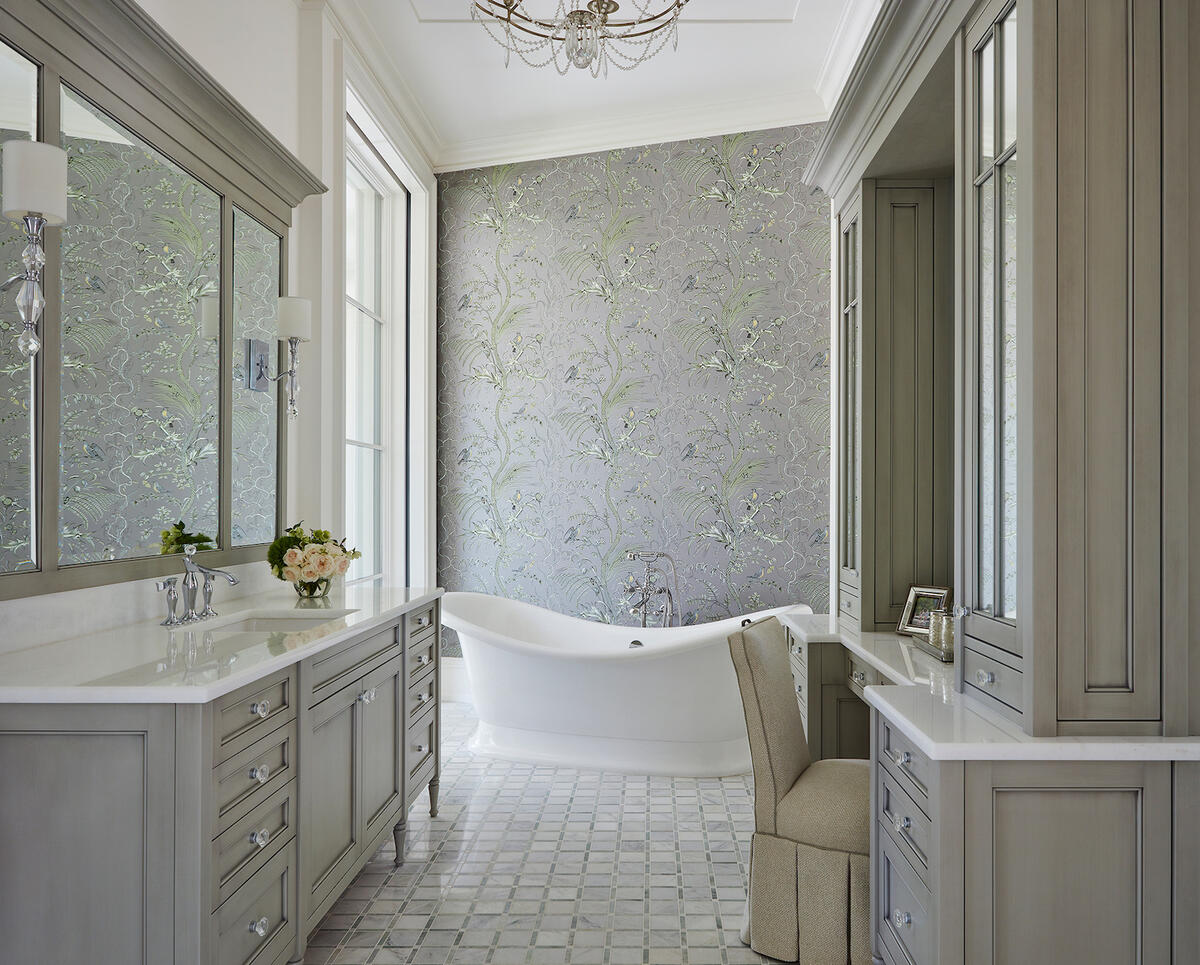
What do you see as the biggest looming challenges for the industry at large?
Bergmann: Talent.
Fix: Talent and [product] damages.
Bergmann: Where is the up-and-coming generation that’s going to make quality products in the future? And not just in the U.S., but internationally? Where are the craftsmen? Where are the woodworkers? Where are the upholsterers? Where are the seamstresses? Where will this talent come from? How are we going to find the people whom we need to execute our design 20 years from now? When we look at a lot of our vendors, our best resources are in their 70s right now, and there are no apprentices coming in to take their place. [And the talent issue] flows into this claims problem that we have across the board with freight logistics and quality control out of the factories, because they’re just having to bring in whatever labor they can get to fulfill orders, which means the skill level has probably lowered across the board. So they just ship some things out, maybe seeing if it will pass and just get accepted.
Fix: We have a drapery workroom and a furniture refinisher who both recently told me that they are training their grandchildren—not their children, but their grandchildren—to take over their businesses. So there’s some hope. But that’s really what it takes: They had a love of what they did, and it might have skipped a generation. To put out a beautiful piece of furniture, there’s pride in that. It takes a level of care, and we would love to see that level of pride and care come back and be appreciated.
What does success look like to each of you?
Fix: Success feels like waking up every day happy to come to work, doing the best that I can, and helping my employees and clients have the best day and the best experiences possible. It’s about quality relationships—and having fun. When that happens, I think the financial success will follow.
Bergmann: What she said, and world peace! But all joking aside, I haven’t accomplished all of my dreams and goals just yet. Knowing that I’m doing what I’m passionate about, I consider it a blessing, not a success. I don’t think everyone gets to experience that, and I feel bad that a lot of people don’t get to experience the same level of professional satisfaction that has nothing to do with monetary return. It’s truly about an emotional feeling at the end of the day. To hear someone say, “I never knew I could live in a home like this,” is just so gratifying. I feel very blessed to be where I am and to have the relationships that I have. The people who are a part of this team and this journey are incredible.
To feel like I’ve achieved success, I want to know when I look back at my career that I’m known for my integrity, that we’ve always tried to do the very best that we could do in every project. It doesn’t mean that we’re perfect by any stretch. But the third element is that I hope to look back and say I built something that is sustainable, meaning that either there will be someone or something that says this should continue, and there is value in what we put together and how we put these firms together, whether that’s here in our local region or beyond. In 20 years, I want to look back and be known as someone who has the foresight, the willingness and the drive to create these businesses and try to build something. I don’t feel like I’ve reached success—I feel like that’s something that I will always be pursuing.
Fix: Beautifully said, Dwayne. I think success for me in the end is that Dwayne and I are joining hands at this point in my career. I thought about what my retirement was going to look like, and I’m not ready to retire. I’m going to work at least another decade. The fact that Dwayne said, “Let’s do this,” felt like another level of wow—that felt like success in the moment.
A lot of our advisers were [warning us that] there’s always fallout [with deals like this, and that] only one in five work, and this and that. But I believe in Dwayne wholeheartedly and could not have asked for a better partner. [For] other people considering collaborating, I want to say, “You never know where it’ll go.”
To learn more about Faith Fix and Dwayne Bergmann, visit Freestyle Interiors and Dwayne Bergmann Interiors online or find them on Instagram here and here.

















